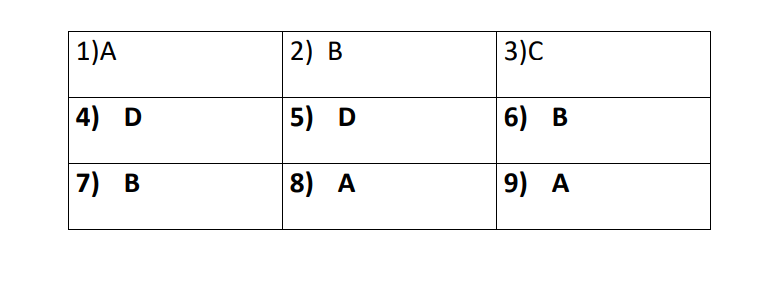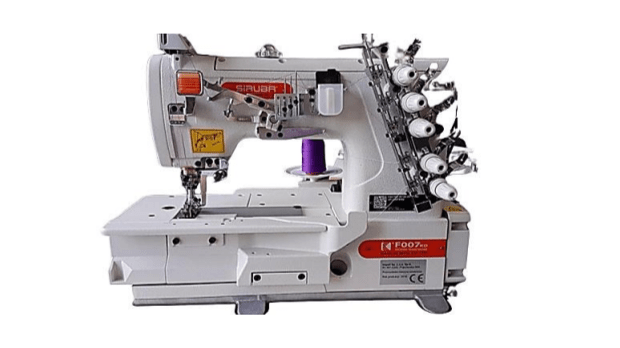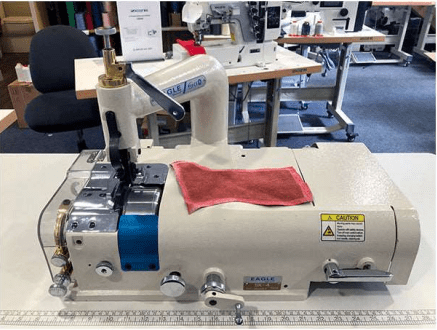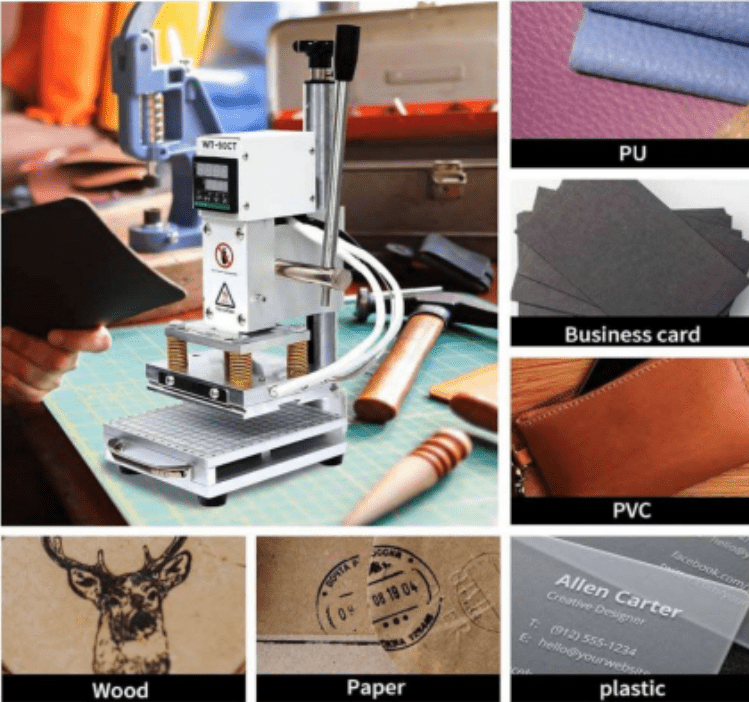Blog
COVERSTITCH SEWING MACHINE

19 minute read
introduction
A cover stitch sewing machine is a type of industrial
sewing machine that uses two to five threads to
create a strong, stretchy stitch for sewing knit
fabrics, such as t-shirts, activewear, and swimwear.
It is designed to mimic the stitch of an
overlock machine, but with a cover stitch, the
threads form a loop on the underside of the fabric,
creating a flexible and comfortable seam.
The cover stitch sewing machine was
invented in the early 20th century as a response to
the growing demand for knit garments. The first
cover stitch machines were developed in the 1920s
and 1930s, with early versions using two threads
and later models introducing three and four
threads.
The modern cover stitch machine has evolved
to include computerized and automated features,
increasing efficiency and productivity in the textile
industry.
Key features:
1.Uses two to five threads: Cover stitch machines
can use two, three, four, or five threads,
depending on the specific model and the
desired stitch type.
2.Creates a strong, stretchy stitch : The cover
stitch is designed to be flexible and durable,
making it ideal for knit fabrics that require a bit
of give.
3.Suitable for knit fabrics: Cover stitch machines
are specifically designed for sewing knit fabrics,
such as cotton, polyester, and spandex blends.
4.Flexible and comfortable seam: The cover
stitch creates a seam that is comfortable
against the skin and allows for flexibility and
movement.
5.Mimics the stitch of an overlock machine: The
cover stitch machine produces a stitch that is
similar to an overlock machine, but with a few
key differences.
6.Industrial sewing machine: Cover stitch
machines are designed for heavy-duty use in
industrial settings, such as textile factories and
garment production lines.
Some additional features of modern cover stitch
machines include:- Automatic tension control:
Ensures consistent thread tension for a professional
finish.
–Adjustable stitch length and width: Allows for
customization of the stitch to suit specific fabric
types and garment styles.
High-speed sewing: Enables fast and efficient
production.
PARTS OF COVERSTITCH SEWING MACHINE


Functions of cover stitch sewing machine parts
1.Thread tension discs are small metal or plastic
discs that regulate the thread tension in a
cover stitch sewing machine, ensuring consistent
stitch quality and preventing thread tangling or
breakage
2.The needle clamp is a small metal or plastic
device that securely holds the needle in place on
the needle bar, preventing it from moving or falling
out during sewing, and ensuring consistent stitching
and preventing damage to the machine or fabric.
3.The slide plate is a removable metal plate that
covers the bobbin area and thread path, allowing
easy access for threading, bobbin replacement, and
maintenance, and can be slid open or removed to
expose the underlying mechanisms for cleaning and
troubleshooting.
4.The pressure foot, also known as the presser
foot, is a metal or plastic foot that applies pressure
to the fabric, holding it in place as it moves under
the needle, and allowing for smooth and even
stitching, with adjustable pressure to accommodate
various fabric thicknesses and types.
5.The feed dog is a small metal or plastic arm that
moves up and down in a circular motion, pulling the
fabric through the machine as you sew, and helping
to guide it smoothly under the needle, ensuring
consistent stitching and preventing fabric bunching
or dragging.
6.The operational panel is the control interface of
the cover stitch sewing machine, featuring buttons,
dials, and displays that allow the user to adjust
settings, select stitch options, and monitor the
machine’s status, providing an intuitive and user friendly experience for operating the machine and
customizing the sewing process.
7.The Integrated Control Box and motor is a
compact unit that combines the electronic controls
and motor of the cover stitch sewing machine,
managing the machine’s operations, such as stitch
length, thread tension, and speed, while also
powering the machine’s movements, providing a
efficient, quiet, and reliable sewing experience.
8.The pressure feet control is a mechanism that
allows you to adjust the pressure exerted by the
pressure feet on the fabric, enabling you to regulate
the amount of pressure applied to achieve
consistent stitching and seam quality.
- The thread take-up lever is a metal arm that
moves up and down to pull the thread through the
machine, taking up the slack and maintaining the
correct thread tension, ensuring a consistent stitch
quality and preventing thread bunching or tangling.
It is typically located on the top of the machine,
near the spool pin, and is often controlled by a
spring or other mechanism to automatically adjust
the thread tension. - The thread guide is a small metal or plastic
component that directs the thread through the
sewing machine, keeping it on the correct path and
preventing tangles or knots.
11.A thread stand is a small device that holds the
thread spool upright and stable, keeping it
organized and within easy reach, and allowing for
smooth thread flow and tension control. It is usually
a small metal or plastic holder that can be attached
to the sewing machine or placed nearby, and is
designed to keep the thread spool from tangling or
falling over.
12.The thread spindle, also known as the spool pin
or thread pin, is a small metal or plastic rod that
holds the thread spool in place, allowing the thread
to unwind smoothly and evenly as it passes through
the sewing machine.
USES AND BENEFITS OF A COVERSTITCH SEWING
MACHINE
1.Professional hems: A cover stitch machine can
create a professional-looking hem on knit fabrics,
especially stretchy ones.

2.Topstitching: A cover stitch machine can be used
to add topstitching to activewear, such as leggings
or workout tops.
3.Attaching elastic or binding: A cover stitch
machine can be used to attach fabric or elastic
binding to swimwear, lingerie, or other garments in
a single step.
- Stretchy seams: A cover stitch machine can be
used to create stretchy seams on activewear, such
as workout pants or tops. - Decorative stitching : A cover stitch machine can
be used to create decorative stitching on garments,
such as a double or triple row of parallel stitching.
A cover stitch machine is a valuable addition to any
sewing room, especially for those who frequently
work with knit fabrics or activewear. It can help
create professional-looking hems, topstitching, and
seams, and can also be used for decorative
stitching.
MAINTENANCE
Maintenance is crucial to extend the lifespan and
optimize the performance of a cover stitch sewing
machine. Here are some maintenance tips:
1.Regularly clean the machine: Use a soft brush
or cloth to remove lint, thread, and debris from
the machine’s interior and exterior.
2.Oil the machine: Apply a few drops of sewing
machine oil to the machine’s moving parts, such
as the needle bar, feed dog, and tension discs.
3.Check and adjust tension: Regularly check the
thread tension and adjust as needed to prevent
uneven stitching.
4.Replace needles and parts: Replace needles
and other parts as needed to maintain optimal
performance.
5.Use the correct thread: Use high-quality thread
suitable for knit fabrics and the cover stitch
machine.
6.Avoid overloading: Don’t overload the machine
with too much fabric or thread, as this can
cause damage.
7.Store the machine properly: Store the machine
in a dry, clean environment, and cover it with a
dust cover when not in use.
8.Perform regular servicing: Schedule regular
servicing with a professional technician to
ensure the machine is in good working
condition.
SAFETY MEASURES
safety measures to be considered when using a
cover stitch sewing machine:
1.Keep fingers away from the needle: Be mindful
of your fingers and keep them at a safe distance
from the needle to avoid accidents.
2.Use the correct needle size: Use the
recommended needle size for the fabric you’re
working with to prevent breakage and injury.
Prevent loose clothing and long hair from
getting caught in the machine.
3.Wear protective eyewear: Wear safety glasses
or goggles to protect your eyes from thread and
fabric debris.
4.Keep the work area clear: Keep the work area
clear of clutter and obstacles to prevent
tripping and falling.
5.Use the machine in a well-ventilated area:
Work in a well-ventilated area to prevent
inhaling thread and fabric dust.
6.Unplug the machine when not in use: Unplug
the machine when not in use to prevent
accidental start-ups.
7.Keep children and pets away: Keep children
and pets away from the machine to prevent
accidents.
8.Use the correct voltage: Use the correct voltage
recommended by the manufacturer to prevent
electrical shock.
9.Follow manufacturer’s instruction: follow the
manufacturer’s instructions and guidelines for
safe machine operation.
Questions
PART A


1)The components labeled as A is known as______________
A) Pressure foot
B) Needle clamp
C) Operational panel
D) Control box
2)The component labeled as B is known as____________
A) Operational panel
B) Integrated control box
C) Feet dog
D) Needle clamp
3) The component labeled as C is known as______________
A) Slide plate
B) Thread tension Dics
C) Feet dog
D) Throat plate
4)The component labeled as D is known as____________
A) Slide plate
B) Needle clamps
C) Feed dog
D) Pressure feet control
5)The component labeled as H is known as_____________
A) thread tension Disc
B) Integrated needdle
C) Spool pin
D) Thread take_up lever
6)The components labeled as J is also known as____________
A) Thread spindle
B) Thread guide
C) Thread take_up lever
D) Opening part
7)The components labeled K Is also known as___________
A) Thread stand
B) Thread guide
C) Thread take_up lever
D) Thread spindle
8)The component labeled as M is also known as____________
A) Slide plate
B) Pressure foot
C) Needle clamps
D) Cover stitch
9)The component labeled as G is also known as__________
A) Needle clamps
B) Pressure control
C) Operational plate
D) Spool pin
10) The component labeled as L is also known
as ___________
A) Pressure foot
B) Needle clamp
C) Slide plate
D) Thread spindle
11) The component labeled as F is also known
as _____________
A) Slide Plate
B) Needle xlamps
C) Integrated part
D) Thread tension discs
12) The components labeled as I is also known
as _____________
A) Operational panel
B) Dog slide
C) Slide plate
D) Thread stand
PARTS B
CHOOSE THE CORRECT ANSWER FROM QUESTIONS
1 – 12
13)What can a coverstitch machine be used for?
A) Only for sewing woven fabrics
B) Only for sewing knit fabrics
C) For creating professional-looking hems,
topstitching, and seams on knit fabrics
D) For embroidery only
14). What is a benefit of using a coverstitch
machine?
A) It can only be used for decorative stitching
B) It can create stretchy seams on activewear
C) It can only be used for sewing woven fabrics
D) It can only be used for sewing straight seams
15) What maintenance tip is crucial for extending
the lifespan of a coverstitch machine?
A) Regularly overload the machine with fabric and
thread
B) Never clean the machine
C) Regularly clean and oil the machine
D) Use low-quality thread
- Why is it important to check and adjust tension
on a coverstitch machine?
A) To prevent uneven stitching
B) To prevent breakage
C) To prevent overheating
D) To prevent rust - What safety measure should be taken when
using a coverstitch machine?
A) Keep fingers close to the needle
B) Wear loose clothing and long hair
C) Keep fingers away from the needle
D) Unplug the machine when in use
18What should be done with the machine when not
in use?
A) Leave it on
B) Store it in a humid environment
C) Store it in a dry, clean environment
D) Throw it away - Why is it important to use the correct thread
for a coverstitch machine?
A) To prevent breakage
B) To prevent uneven stitching
C) To prevent overheating
D) To prevent rust
20.What should be done with children and pets
when using a coverstitch machine?
A) Keep them close to the machine
B) Keep them away from the machine
C) Let them use the machine
D) Ignore them
21.What is a benefit of using a coverstitch machine
for topstitching?
A) It can only be used for decorative stitching
B) It can create stretchy seams on activewear
C) It can add a professional finish to garments
D) It can only be used for sewing straight seams - Why is regular servicing important for a
cover stitch machine?
A) To prevent breakage
B) To prevent uneven stitching
C) To ensure optimal performance
D) To prevent rust
D) None of the above
Parts C
Fill in the gap from 23 to 50
23)What type of industrial sewing machine is a
cover stitch sewing machine?
24.How many threads can a cover stitch sewing
machine use? ___________
25.What type of fabrics is a cover stitch sewing
machine suitable for? ___________
26.What is the main advantage of the stitch created
by a cover stitch machine?
27.Who is the target audience for cover stitch
machines? ___________
28.When was the cover stitch machine invented?
29.What was the driving force behind the
development of the cover stitch machine?
30.How many threads did early cover stitch
machines use? ___________
31.What is the name of the stitch produced by a
cover stitch machine?
32.How does the cover stitch machine mimic the
stitch of an overlock machine?
- What is the benefit of the flexible and
comfortable seam created by a cover stitch
machine? ___________ - What is the purpose of automatic tension
control in modern cover stitch machines?
- What is the advantage of adjustable stitch
length and width in modern cover stitch
machines? ___________ - How does high-speed sewing enable fast
and efficient production?
- What is the purpose of computerized
controls in modern cover stitch machines?
- How has the modern cover stitch machine
evolved from its early versions?
- What is the main difference between a
cover stitch machine and an overlock machine?
- What is the significance of the cover stitch
machine in the textile industry?
- What regulates thread tension in a
coverstitch sewing machine ____________ - What holds the needle in place in a
coverstitch sewing machine _____________ - What allows access for threading and
maintenance in a coverstitch sewing machine __________ - What applies pressure to fabric in a
coverstitch sewing machine___________ - What pulls fabric through the machine in a
coverstitch sewing machine __________ - What controls the machine’s operations in a
coverstitch sewing machine __________ - What powers the machine’s movements in
a coverstitch sewing machine __________ - What adjusts pressure on fabric in a
coverstitch sewing machine __________ - What takes up thread slack in a coverstitch
sewing machine –___________ - What guides thread through the machine in
a coverstitch sewing machine ____________
INSTRUCTORS COPY
ANSWERS TO MULTIPLE choice QUESTIONS
1_22


Answers to fill in the gap from 22 to 50
- Industrial sewing machine
- Two to five threads
- Knit fabrics
- Flexible and durable
- Textile industry
- Early 20th century
- Growing demand for knit garments
- Two or three threads
- Cover stitch
- Loop on the underside of the fabric
- Flexible and comfortable seam
- Consistent thread tension
- Customization of stitch
- Fast and efficient production
- Simplifies sewing process
- Computerized and automated features
- Type of stitch and number of threads
- Efficient and productive sewing of knit
fabrics - Thread discs
- Needle clamp
- Slide plate
- Pressure foot
- Feed dog
- Operational panel
- Integrated motor
- Pressure control
- Thread take-up
- Thread guide















